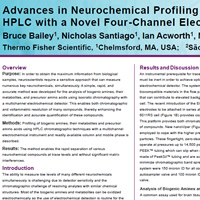
ADVANCES IN NEUROCHEMICAL PROFILING OF BRAIN TISSUE BY HPLC&NEW ELECTROCHEMICAL ARRAY DETECTOR Bruce Bailey(1), Nicholas Santiago(1), Ian Acworth(1), Marc Yves Chalom(2) Thermo Fisher Scientific, 1-Chelmsford, MA, U.S.A., 2-São Paulo, SP, BR |
Resumo do Pôster:The ability to measure low levels of many different neurochemicals simultaneously is challenging due to detector sensitivity and the chromatographic challenge of resolving analytes with similar chemical structures. Most of the biogenic amines and metabolites can be oxidized electrochemically so the use of electrochemical detection is routine for the analysis of these compounds. Chromatographic techniques have advanced over the years, however, even with the use of UHPLC columns, baseline resolution of many different analytes still remains difficult due to the constraints of isocratic HPLC mode for their separation. Although gradient elution would improve analyte resolution, electrochemical detection is typically only used with isocratic approaches due to adverse effects on detector performance. The method was both highly sensitive and rapid. All compounds were analyzed within 15 minutes and with limits of detection of less than 10 picograms on-column. Voltammetric resolution offers better insights into the proper identification of individual compounds since each will have a unique but reproducible pattern across the four electrode channels. |
